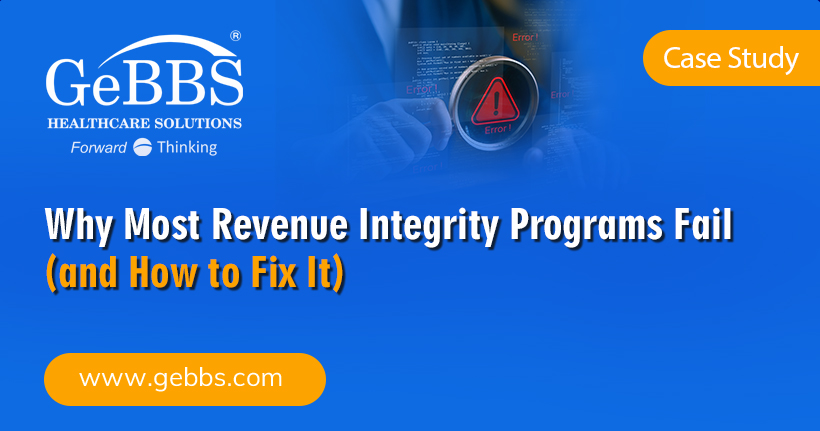It starts with one denial. Then suddenly, you’re neck-deep in follow-ups, your team’s buried in emails, and the clock is already ticking toward month-end close. Blink. And you’ve lost another day just trying to stay afloat.
Maybe it happened not too long ago…when a simple eligibility error turned into a full-blown backlog and three departments started pointing fingers. You were left trying to untangle the mess and keep morale up, while somehow still hitting your revenue targets. Talk about draining.
Though it may feel like your hospital revenue cycle is always in crisis mode, the constant reactivity doesn’t have to be your default setting. There’s a way to break the cycle and get back in control. Let’s walk through five proven ways to do just that.
1. Fix Front-End Friction That Derails Everything Downstream
A lot of hospital revenue cycle chaos doesn’t start in the business office. It starts up front at intake. Small issues like a wrong insurance ID or a missing authorization may not seem like much in the moment, but they create a ripple effect that crashes into your team days or weeks later. Denials pile up. Appeals get bottlenecked. Staff spends more time fixing problems than preventing them.
This kind of friction isn’t just frustrating. It’s expensive. Every correction requires time, effort, and resources you don’t have. The smarter move? Stop the problems before they ever enter the revenue cycle.
That means training front-end staff like they’re part of the RCM team. That’s what they are, after all. So equip them with real-time eligibility tools that flag mismatches before the patient even sees a provider. And don’t stop there. Investing in patient education helps clear up coverage confusion so it doesn’t become your problem two weeks down the line.
2. Automate the Painfully Repetitive Stuff
There’s a good chance your team is spending too much time on the same handful of mind-numbing tasks: claim status checks, data entry, eligibility verifications. You may be thinking, “What can I do? These things have to get done.”
Of course they do. But when staff are stuck doing the same repetitive work day in and day out, it burns out your best people and leaves little energy for the bigger problems that actually need their brainpower.
Automation changes that. Whether it’s bots that check claim status in bulk or tools that pull eligibility data without staff intervention, automating these tasks gives your team back their time and actually empowers them. When routine work is offloaded, they can focus on high-value tasks like resolving complex denials and actually thinking strategically, transforming your hospital revenue cycle in the process.
3. Stop Relying on Spreadsheets to Track Performance
And while we’re on the topic of automation, it might be time to reconsider your team’s reliance on spreadsheets. Sure, they’re fine for one-off reports. But for spotting red flags or managing a fast-moving operation? They fall short fast. By the time you’ve opened the file, hunted through tabs, and pieced together what’s happening, the real problem has already grown bigger.
What you need is real-time visibility. Dashboards and predictive analytics platforms let you monitor KPIs as they shift. They show you which claims are aging out, which payers are dragging their feet, and where your team is getting stuck—before it costs you.
Think of it this way, a spreadsheet tells you what did happen. A dashboard tells you what is happening. That difference is everything when you’re trying to move from reactive to proactive. It might feel like a leap to move away from systems your team knows. But the truth is, hanging onto outdated tools is like fighting a wildfire with a garden hose. You need better equipment.
4. Create a Denials Command Center
Denials shouldn’t be a mystery you’re always scrambling to solve. They should be a metric you actively manage. When teams operate in firefighting mode, every denial is treated like a new problem. Someone looks it up and resolves it. But that same issue often pops up again next week, and the cycle starts over.
A better approach? Centralize your denial management. Group denials by type. Look at root causes. Identify patterns. Once you know what’s recurring, you can build playbooks for how to respond.
Take common issues like missing modifiers or authorization errors. Each one has a fix and probably some workflow changes to go along with it. By planning for these problems before they strike, you can get out of emergency mode and into a rhythm of prevention.
5. Reclaim Your Team’s Focus With Clear Ownership and Roles
In a chaotic hospital revenue cycle, everyone is busy but no one’s quite sure of who owns which responsibilities. One person’s following up with payers while another’s working denials, and a third’s jumping between tasks because no one else has the bandwidth. How exhausting, right? But the problem goes deeper than inefficiency and fatigue. Duplication of effort or missed steps can quietly bleed revenue.
The fix is simple, but powerful: clear ownership. Who handles appeals? Who pulls reports? Who escalates payer issues? When everyone knows their lane, the work flows cleaner and people stop stepping on each other’s toes.
This also creates breathing room. Instead of always reacting, staff can get ahead on projects and build new workflows. Structure creates clarity. And clarity brings calm.
Take Control of Your Hospital Revenue Cycle
The chaos doesn’t have to continue. When you fix the intake issues, automate manual tasks, and ditch the spreadsheets, everything begins to shift. Denials no longer blindside your team—they’re anticipated and handled with confidence.
This is the dawn of a brand new day. One that no longer starts with a feeling of dread, but with confidence and the energy to focus on high-value work. With a plan and a purpose, your team gets clean claims out faster and payments arrive sooner. And the tension that once filled the office? It’s replaced with a sense of calm and control. This is what a proactive hospital revenue cycle looks like. It’s not out of reach. Ready to ditch firefighting and reclaim your revenue cycle? You don’t have to go it alone. GeBBS’ Revenue Cycle Management Solutions offer a proven way to help you get ahead of denials and streamline your operations. Want proof? Our results say it all. We handle 60 million+ charts coded annually, drive a 75%+ reduction in EM‑leveling issues, and deliver an average 11% revenue boost through audits and education. When intake is clean, denials decline and high‑value tasks take center stage. Your organization shifts from survival mode to sustainable performance and more revenue. Let us help you get there. Contact us today






